 |
Flying High With Electric Power!
The Ampeer ON-LINE!
Fly the Future - Fly Electric! |
Site Table of Contents
| President: | Vice-President: | Secretary/Treasurer: |
| Ken Myers | Richard Utkan | Rick Sawicki |
| 1911 Bradshaw Ct. | 240 Cabinet | 5089 Ledgewood Ct. W. |
| Commerce Twp., MI 48390 | Milford, MI 48381 | Commerce Twp., MI 48382 |
| (248) 669-8124 | (248) 685-1705 | 248.685.7056 |
 | ||
| Board of Directors: | Board of Directors: | Ampeer Editor |
| David Stacer | Arthur Deane | Ken Myers |
| 16575 Brookland Blvd. | 21690 Bedford Dr. | 1911 Bradshaw Ct. |
| Northville, MI 48167 | Northville, MI 48167 | Commerce Twp., MI 48390 |
| 248.924.2324 | 248.348.2058 | 248.669.8124 |
| Mailed Ampeer printed subscriptions are no longer available.
The Ampeer is FREE on-line in Acrobat .pdf format and HTML with active links! | ||
| The Next EFO Meeting:
Date: Wednesday, Feb. 11 Time: 7:30 p.m. Place: Ken Myers' house, address above NOTE: Meeting date changed to 2nd WEDNESDAY of the month | ||
| What's In This Issue? | ||||
| The Tactic TTX850 8CH Transmitter & 8CH TR825 Review and Comparison to the Tactic TTX650 Ken reviews this new 8-channel transmitter and compares it to the Tactic TTX650. | A123 1100mAh Cells, End of an Era, Erik Vandermey notifies us that the 1100mAh cell will no longer be available. | |||
| An Alternate Throttle Lock Method for Spektrum Radios Bob Comerford shares his thoughts on the topic. | ||||
|
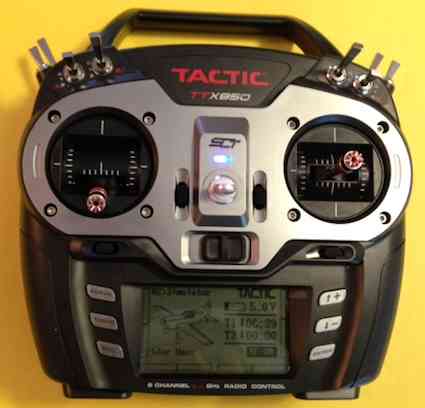
The Tactic TTX850 8CH Transmitter
After reviewing the Tactic TTX650 and TR624 receiver in the July 2013 Ampeer, I was happy to hear that the long awaited TTX850 was available. I started flying the Tactic TTX650 6CH computer transmitter with the Tactic TR624 6CH receiver in May of 2013. Through the end of the 2014 flying season I had logged 338 flights on nine different airplanes with no problems, period, using TR624 receivers. I have several of the TR625 6CH receivers with the twin antennas, for better signal diversity, but they've yet to be installed in any aircraft. By the Mid-Am of 2014, I decided to sell my two Hitec 2.4GHz systems and go completely with Tactic. The five major reasons that I switched completely were; the Tactic system is reliable, day-in and day-out, the system links a zillion times easier than the Hitec, the TTX650 uses 'AA' batteries, the programming is extremely simple to do using the push buttons, and the receivers are reasonably priced, compared to what I paid for Hitec 2.4GHz receivers and my old 72MHz receivers. Joe Hass offered to loan me his new TTX850 and TR825 receiver for this review. Thanks a ton Joe!!! Before continuing to read this review, I strongly recommend reading the following background information regarding the Tactic TTX650 and TR624 receiver. Tactic TTX650 6-Channel 2.4GHz SLT Computer Transmitter and TR624 6-Ch Receiver Review More on the Tactic TTX650 and TR624 Receiver, From Joe Hass Tactic Brand Radio: A Follow Up, By Ken Myers A Better Way to Set Up the Throttle Cut Feature on the Tactic TTX650 to be Used as a Throttle Lock, From Roger Wilfong The articles contain the history of the Tactic system, important notes on its use, errors in the TTX650 manual and other information that will not be repeated in this review. Before I received Joe's system for review, I downloaded the manual for the TTX850. The manual, noted as TACJ2850 v1.1, is the same on both the Tower Hobbies and Tactic RC Web sites. I could not find a comparison of the features of the TTX650 to the TTX850, so I created one. (see below) |
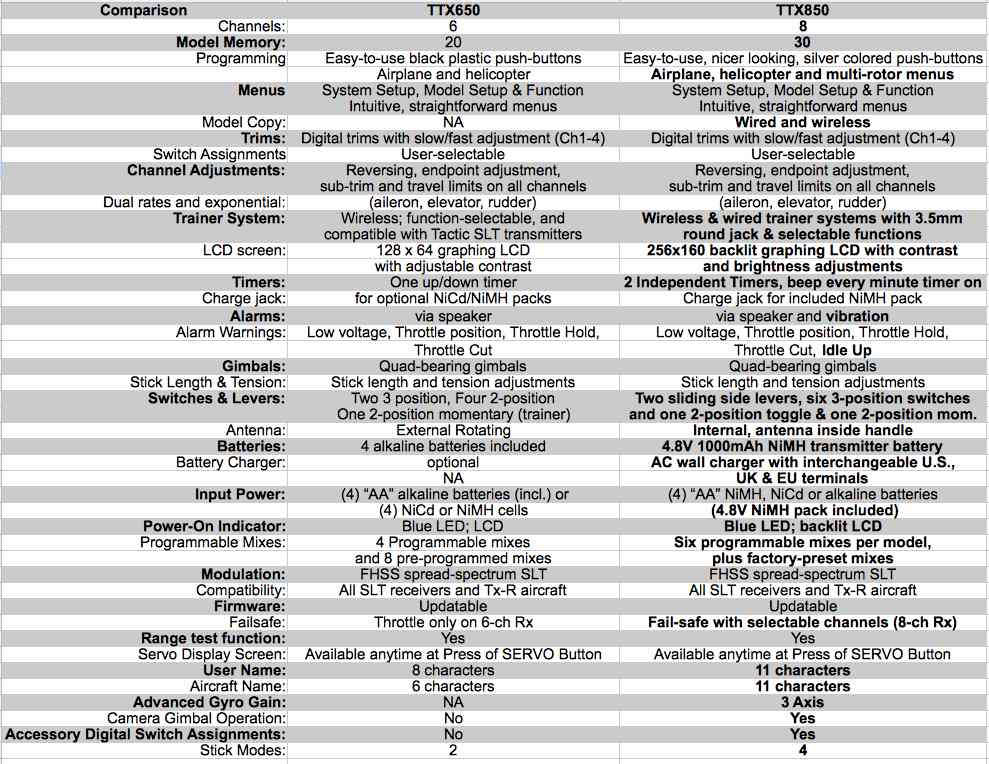
|
Bold print is used in the comparison table to note changes, additions or other significant differences between the TTX650 and TTX850. Significant changes include, two more channels, 10 more model memories, Multi-rotor Setup, addition of wired and wireless model copy, addition of 3.5mm round buddy box jack, higher resolution backlit LCD screen, addition of a second timer, internal antenna in the handle, and additional programable mixes and presets. |
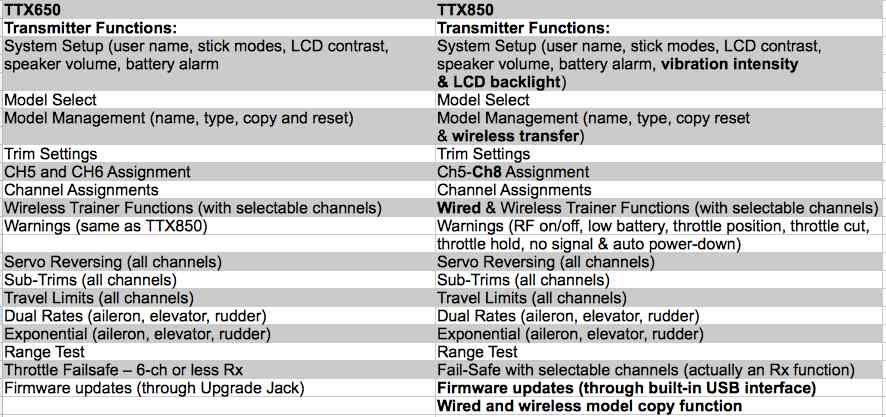
|
The table above shows the transmitter functions. It is interesting to note that there is a vibration intensity setting. That setting indicated that the transmitter vibrates when warnings are sounded, even though it is not noted anywhere, and it does. |
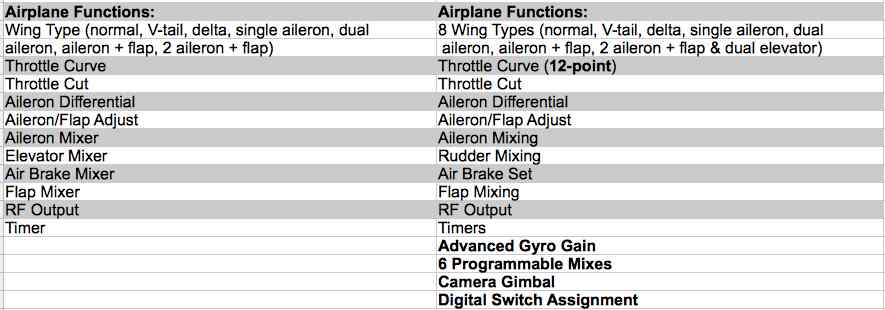
|
The Airplane Functions include a smoother throttle curve and four new functions; Advanced Gyro Gain, 6 Programmable Mixes, Camera Gimbal and Digital Switch Assignment. |
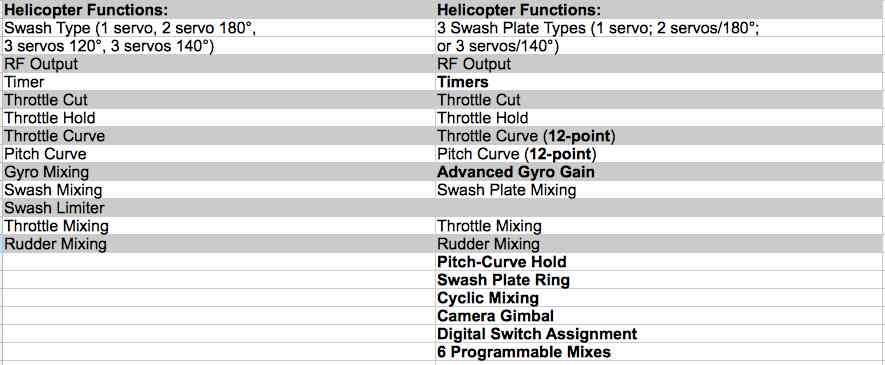
|
The Helicopter Functions have been refined and new functions added. 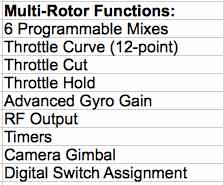 Multi-Rotor Functions have been added. The System Setup has two added selections; Vibration Power and Back Light. The HOME SCREEN on the TTX650, the screen that is shown when the transmitter is ready to go, displays the flight control trim positions, an aircraft type graphic (airplane or helicopter), memory slot number, aircraft name, timer, RF On/Off indicator and the battery voltage in numerical volts. 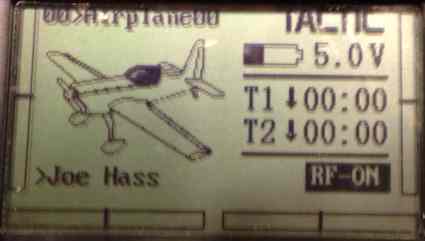
TTX 850 HOME SCREEN The TTX850 has added the user's name, additional aircraft type graphic (multi-rotor), a second timer and a remaining battery status graphic to the HOME SCREEN. There is a table in both manuals, p. 8 TTX650 and p. 6 TTX850, that displays the default functions for switch assignments for Airplanes and Helicopters, and the addition of multi-rotors for the TTX850. The switches in both tables are identified alphabetically with letters on both transmitters near the switches referenced in the tables. As noted in the July 2013 review, "SLT technology is an open protocol. That means that we allow partners to use the protocol integrated into their own radio." Hitec is a 'partner' and has integrated the protocol into their most recent transmitters, but not their receivers. On p. 3 of both manuals it notes, "The TTX850 (TTX650 km) is also compatible with non-Tactic brand receivers which use the *SLT protocol, for the ultimate in convenience and flexibility." In May of 2013 there were no non-Tactic brand receivers using the SLT protocol. Hobbico, through Tower Hobbies, is now marketing an inexpensive, non-computer Tower Hobbies 424 4-Channel 2.4GHz Tx/Rx system. The system, Tx & Rx, uses the SLT protocol and the receiver (Rx) appears to be very similar to the Tactic TR624 6-channel. Throttle tension is very important to the feel of the radio and should not be ignored. This topic was covered by Jim Hiller in his RC Jets column in the January 2015 Model Aviation, page 111. I found his tip about adjusting the right stick, for Mode 2 fliers, that's most of us in the USA, very helpful. Even though most folks use Mode 2 in the USA, there are 4 possible stick modes with the TTX850. Mode Change, How to found here This is what Jim said that was an Ah-Ha moment for me. "A fellow pilot taught me that a medium elevator spring setting and harder aileron spring tension make it difficult to accidentally move the stick off to the side, inputting roll when pulling back on the stick." The article also contained other helpful tips about spring tension. It is recommended reading. It is well worth the time spent to remove the back of the transmitter and set the tension to your liking. How to remove the back is covered in both manuals. Follow the directions carefully. In the System SETUP menu, the User Name was increased to 11 characters from 8 in the TTX650. The vibration feedback on/off and back light intensity are also adjusted in this menu. I have several models in my main TTX650 transmitter. I think this non-flying season is a good time to follow the recommendation found in both manuals, "It's a good idea to keep a record of all settings for each memory as a backup in case parameters in a particular memory are accidentally changed, etc." (I actually did it for my Easy Star and Antonov An-2 to use as a guide while setting up the TTX850. A spreadsheet was created in Excel format to archive my TTX650 settings. There are spreadsheets that can be used as a templates for both the TTX650 and TTX850. The link to the Excel workbook spreadsheets is here.) The TTX850 also allows up to eleven characters to be used for aircraft naming. That was a much needed improvement over the six character maximum of the TTX650. The transfer of aircraft setups can made between two TTX850s. The speed of the servo rotation can be set in the transmitter for channels 5 through 8 of the TTX850. Up to 3 axises of an onboard stabilization gyro's gain can be set in the TTX850. The TTX650 has four programable mixes available and the TTX850 has six. The two timers, displayed on the HOME SCREEN of the TTX850, can be set to run at the same time as count up or count down timers and toggled from a switch or the throttle control. From the TTX850 manual, "DIGITAL SWITCH ASSIGNMENTS - Functions in this screen can support the use of miscellaneous accessories in the model, and can range from video, still camera, LEDs, etc." There are many special features for the helicopter and Multi-Rotor setups as well. The new unit was picked up from Joe Hass on Sunday, January 4. He noted that he had charged it. The manual notes that the battery is completely charged when the light on the charger turns green. The charger's light is red while charging. I discovered that when the charger's AC plug is plugged in, the charger's light displays green even before being connected to the charge socket in the transmitter. The charger light is supposed to be green when the battery is fully charged. Once plugged into the charger socket, the charger light switches to red, if the battery needs charging. I checked the battery voltage with an expanded scale voltmeter and it showed 4.9V. I could have just turned on the transmitter as well to check the voltage, but since the back was off and the meter handy, I used it. 4.9V is NOT a fully charged NiMH pack. The battery was then reconnected to the transmitter. The charge plug was inserted into the charge receptacle of the transmitter and the charger plugged in. The charger indicated that it was charging by displaying the red light. Since I had time to continue the set up of the transmitter for this review at that moment, I swapped the battery box, with 4 'AA' cells, out of one of my TTX650s, and plugged the NiMN pack into the TTX650 to continue charging. The stick lengths were adjusted to my preference. The battery pack was removed. Two folded bath towels were used to 'bed' the transmitter face down on the workbench. The six screws in the back of the transmitter were removed. The aileron stick tension adjustment was tightened to the maximum and the rudder some. The elevator tension and throttle were left alone.  With the back off the transmitter, the antenna placement was noted. It runs horizontally across the handle. The 4-cell 'AA' pack was reinstalled. The User Name, Contrast, Battery Alarm and Back Light were adjusted. As the Back Light is adjusted it becomes brighter and more orangish red. The Batt. Alarm is factory set at 4.2V. At first, I felt that 4.2V was too low. On p. 27 of the manual, in the TTX850 Specifications, it notes, "Input Power: 3.40 - 7.00V DC". 3.4V, the minimum voltage, is about 80% of the default 4.2V. (4.2V * 0.8 = 3.36V) That makes sense to me now. I did change the Batt. Alarm to 4.3V. (4.3V * 0.8 = 3.44V) Next I jumped to the linking step. Linking is known as binding in the 'Spektrum World'. This is a very, very simple process with Tactic radio equipment. Nothing needs to be done with the transmitter, except to turn it on. Power is applied to the receiver and the Link button depressed in the receiver until the light in the receiver blinks twice. The pressure is released on the Link button and the red light stays on in the receiver. The transmitter and receiver are linked. I prefer to do this process on the bench. It is much, much easier. I use a round toothpick to depress the Link button. Power is provided to the receiver using an old 4-cell NiMH pack. A servo is attached to the aileron socket of the receiver. That's it. It couldn't be easier. There were absolutely no surprises in linking this system. When I finished Linking on the bench, I noticed that the wall charger light had turned green, indicating that the NiMH pack was fully charged. I switched the packs around again, putting the NiMH pack back in the TTX850. A switch harness was added to the bench setup to see how fast the TR825 receiver reacquired the signal from the transmitter. It is almost instantaneous. I no longer have a non-computer Tactic transmitter, so I could not test how quickly the receiver reacquired the signal from the transmitter, but the test for the TR624 and Tactic TTX600 was extremely FAST in a previous test! After setting overnight, about 15 hours later, with no transmitter usage, the voltage read 5.4V on the Tactic TTX850 Home Screen. That is a loaded voltage. The ESV loaded voltage showed just over 5.3V. A Fluke multimeter showed 5.551V, with no load. The first plane set up was a Multiplex Easy Star. It was a very simple setup with only rudder, elevator and throttle. This plane was set up first so that there MIGHT be a possibility to do a flying range test before publication of this review. The spreadsheet, created from my TTX650 settings, was used as a guide to set up the TTX850. Setting up the throttle cut function as a throttle lock is different, compared to the TTX650. Instead of noting the whole throttle range as 100%, as on the TTX650, it shows numbers 100% plus and minus from the center. The bottom 1/2 of the range is plus (+) and the top (-). The servo connectors and throttle connector were removed from the TR624 in the Easy Star and hooked up in the same order to the TR825 receiver. The transmitter was turned on and then the 2S A123 2300mAh A123 power pack connected to turn on the battery eliminator circuit (BEC). Everything worked as expected, except that I forgot to set the trims using the SERVO button to match the trims on the TTX650. After the failsafe was set, an extremely simple process described in the manual and much like linking, it was tested. The transmitter was turned off while the motor was running and the failsafe shut down the motor as expected, but the shut down was not instantaneous. There was at least a one second lag. Next I set up my most complicated plane, a Maxford USA Antonov An-2. It has independent servo control of each aileron, and it also has flaps. The ailerons are mixed with the some rudder via a switch. The ailerons are also mixed to 'droop' with the flaps. At full flap deployment, there is some down elevator mixed in. Dual rates are also used on the ailerons and elevator and the dual rate function of the rudder used to cut the throw to 40%. The travel function could also have been used to cut the rudder throw. I set up dual rates by making the upper most or rear most position of the 3-position switch the low rate and BOTH the down or most forward 2 positions identical throws for the high rate. Therefore my normal throw position is every switch up or back and high throws any position down or forward. The rudder has all three positions set to the same amount of throw. The MODEL MANAGEMENT menu was extremely difficult to comprehend. The Easy Star was easy, as it was set up in model memory 00 in the list. Memory 00 showed a graphic of an airplane and said Airplane00, so it was ready to go. Memory 01, the second memory position, showed a graphic of a helicopter and said Helicopter1. This confused me. I could see that model memory 02, the third memory position, displayed a multi-rotor and said QuadNumber3. I couldn't find a 01 airplane in the list. Head scratch. After much vexation I figured out that after the memory slot 01 is selected, even though it says Helicopter2, the Model Type can be changed to Airplane in the MODEL MANAGEMENT menu, p. 9 of the TTX850 manual. There is no indication of this process in the manual. It would have been better for the end user if they didn't show a model type name or graphic in the memory selection. It would have been helpful if there was a note in the manual that the model type can be changed after selecting the memory number. The bottom line, when selecting the next memory number, is to just IGNORE the graphic and preselected model type. It can be changed in the MODEL MANAGEMENT menu. The setup for the An-2 was finally accomplished after much vexation. (See: A Setup Anomaly, Maybe? at the end of the review) The setup for the An-2 was finally accomplished after much vexation. (See: A Setup Anomaly, Maybe? at the end of the review) Finally a third model was set up to use an RC flight simulator, aerofly RC7, wirelessly with the TR825 receiver. A plane was flown in the simulator for 6 minutes and 30 seconds. The timer was activated by the throttle stick, a preference of mine. Once the count down timer started, the transmitter beeped every minute. I could find no way to turn off this 'feature'. If it beeped the number of minutes, it would be more useful. The wireless trainer link worked perfectly when paired with a Tactic TTX650 as the student's transmitter and TTX850 as the instructor's. The wired trainer output works when 'wired' to a simulator and the simulator set up is adjusted for the inputs. The WIRED TRAINER directions on p. 24 are pretty much useless, in my opinion. If a student pilot came to the field and had a Tactic Radio installed, buddy boxing is easy to do wirelessly. No need for a cord. If the student came to the field with a Spektrum brand setup, the student's transmitter needs to be used by the instructor and the TTX850 is used by the student as the buddy box. For the TTX850 to be used as a buddy box, the channel assignments need to be changed to match the Spektrum receiver channel assignments. The TTX850's servo reversing also needs to be changed to match that of the Spektrum radio. I actually did this on the bench, and it worked well. If someone spends a lot of time instructing, it would be a good idea to set up a buddy box in one of the memories of the TTX850 and set up the channel assignments to the Spektrum order. The servo reversing matching would have to be done at the field, but at least it could be mostly ready to go. I cannot think of a situation where the TTX850 would be used by the instructor to a wired 'other' brand transmitter for buddy boxing. The set up is extremely difficult to do. I couldn't do it. Overall, the wired buddy box is a good idea for RC flight simulators and when being used as the student's buddy box with the matching trainer cord from their non-Tactic transmitter. The Tactic TR825 Receiver is designed to take full advantage of all 8-channels of the TTX850. It features twin 5.9" (15 cm) shielded, coaxial antennas and has failsafe available on all channels. Its input power is rated from 3.6V to 8.4V. That means that a four or five cell alkaline, NiCd or NiMH pack can be used, or 2S LiPo or 2S LiFe pack. Tactic Web site, Receivers Specifications page Current Tactic receivers - actual measured data: TR624 Wt. 8.7g/0.31 oz. L-1.765" x W-1.02" x H-0.545" TR625 Wt. 9.4g/0.33 oz. L-1.765" x W-1.02" x H-0.545" TR825 Wt. 10.05g/0.35 oz. L-1.775" x W-1.132" x H-0.532" The proof is in the flying. The radio is so new that there are very few flight reports on it yet. RC Groups' member, Fentonflyers, did report on January 1, "I had an unexpected opportunity to get about a half an hour to fly this afternoon. I took my ST Models Acrobat and set it up on this radio.
I purchased a Flyzone Tx-R ready Tiger Moth from Nankin Hobby in Farmington, MI. On Thursday, Jan. 15, it was flown at the Legacy Center in Brighton, MI. The Legacy Center is a HUGE, inflated dome type building. The venue is an extremely 'radio rich' environment. The main flight line always had eight to twelve folks flying. Additionally, there were at least three folks flying 3D at one end of the venue and four or five folks flying multi-rotors at the other end. The Tiger Moth was Linked at home to the TTX850. There was no issue with the Tiger Moth's receiver 'finding' the TTX850 during the indoor session. The TTX850, paired with the Tiger Moth, flew well and without a problem for 6 flights. On January 16 I was able to take up the Easy Star. It was 27 degrees, partly sunny and the winds were from the northwest at 10 mph to 15 mph. Not ideal conditions, but flyable. I flew the Easy Star as high as I could see it well and as far away as I normally fly my planes. The TTX850 and TR825 performed well, with no discernible hiccups. The TTX850 and TR825 'receiver' performed well, as expected. FrSky, Futaba, Spektrum, JR, Airtronics, Hitec and many of the fruity radios all offer aircraft onboard telemetry back to the transmitter. The Tactic radios don't. Is that a big deal? Only you can really decide. For me it is not. On January 2, 2015 I started a thread on RC Groups titled What Tx telemetry do you use most often - not poll It only got a few comments for a few days and then just died. The most used telemetry function was the Received Signal Strength Indication (RSSI) or Link Quality Indication (LQI). This type of indication suggests how well the signal is being received by the receiver. It can be used to assist in the best placement of the receiver and its antenna(s) in an aircraft. The second most used telemetry feature was the inflight power battery voltage or capacity indication or alarm. For ME, the Tactic radios 'work' reliably enough to not be concerned about the radio link, and I can use a timer. For others, that may not be true. The transmitter comes with a 4-cell 1000mAh nickel-metal hydride (NiMH) battery pack installed and wall charger. I prefer 'AA' primary batteries. NiCd and NiMH cells require a lot of maintenance through the off season and regular testing of their capacity. All of my planes are electrically powered and most use battery elimination circuits (BEC), so the receiver power is always supplied through the BEC by the power system battery. Except for one, these 'planes' never need receiver power charging. 'AA' batteries are available on almost every corner, everywhere. I carry replacement 'AA' batteries with me all flying season long. When the low voltage alarm sounds, I simply pop in a new set of batteries. For me, after over 5 decades in RC, this is just the easiest way to always have my transmitter ready for use. There are many valid reasons for folks to 'want' to use rechargeable packs. For them, this is a good deal. In the past, I have used Eneloop low self-discharge (LSD) cells with very good results. If I were to use rechargeables in this system, I'd switch to Eneloops after the first year of use. Unfortunately, Tower Hobbies/Hobbico, do not offer an 'AA' flat battery holder, even though they note, "optional 4-cell flat battery holder with universal connector" in the TTX850 manual. The one listed in the ACCESSORIES section of the manual, p. 29 is not the one needed for the transmitter. It is the square-type that can be used as a receiver pack. I searched the Internet and found that, at least on the Web site, Radio Shack still sells them, so I could make the change in this transmitter. I would buy one immediately if I had a model, or was planning an upcoming model, that required more than six-channels. I believe it is a super value for an 8-channel radio. I like a lot of the new features, but I don't need an extra 10 model memories. I don't need, or want, NiMH batteries. While the screen looks better overall, the menu font, character size, is difficult for me to read comfortably. 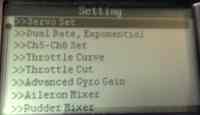 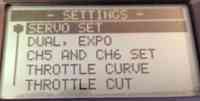
TTX850 Setting Menu on left, TTX650 Settings Menu on right There is even one place where I struggled, even with the use of a magnifying glass, to read the characters. In the SYSTEM SETUP menu, the sub-menu RF OUTPUT selection RF PROTOCOL: shows SLT as the default. It can be switched to NE, but because of the way the N looks, I had to get it in the 'right' lighting conditions to be able to read it with the magnifying glass. What NE means is not noted in the manual. Fentonflyers made a post in the TTX850 Review thread on RC Groups that cleared up what NE most likely means, Nine Eagles. I was unfamiliar with Nine Eagles. A Google search was made for Nine Eagles Protocol. Several pages were found on the Internet relating to this protocol. Here is just one. There appears to be some relationship between Hobbico's Heli-Max line and Nine Eagles. Compare the Heli-Max offerings to those branded as Nine Eagles. I really, really like this transmitter very much, but there is not enough benefit to change from my TTX650s, AT THIS TIME. The TTX650 isn't 'perfect'. It doesn't have all of the features I'm looking for either. 1. The two small screws in the handle should be easier to remove - locating a screwdriver for the screws in the handle is problematic, include a screw driver for the small handle screws 2. Wireless transfer of parameters from one TTX850 to another - Not explained well in the manual, add better explanation in manual 3. Add a note to the manual that the model type is changed in the MODEL MANAGEMENT menu AFTER selecting the model memory number. 4. DUAL-RATES, EXPONENTIAL - all of the switches that would be used for dual rates are 3-position switches, rename the function to RATES & EXPONENTIAL, explain in the manual how to set up dual rates on a 3-position switch 5. Timer beeping changed - allow the timer beep to be shut off or change the single beep to a series of beeps relating to the number of the minutes the timer has been on 6. WIRED TRAINER - a second, and in my opinion, more useful, section needs to be added to the manual describing how to set up the TTX850 as the student's box and 'other' brand set up in the aircraft as the instructor's box. 7. Menu font size - the higher resolution screen characters, font size, are smaller and a bit harder read in the programming menus compared to the TTX650, increase the font size 8. Manual lacks helpful graphics and photos found in TTX650 manual - add the equivalent photos and graphics to the TTX850 manual 9. No 'AA' dry cell battery box available - make available as option or supply with Tx. 10. Plane Choice yes/no at transmitter initialization - not available but, there is a very simple programming step that could help prevent flying the wrong aircraft. It is NOT foolproof, but it would help a lot. When the transmitter is turned on, a window opens and asks
If 'Yes' is chosen, the transmitter goes to the HOME SCREEN and the aircraft is ready to be turned on
This would be extremely easy to program and would require very little memory. I believe it would be a nice, added safety feature. Tactic TTX850 - RCGroups Review A Solid 8 CH 2.4GHz Radio for $179.97? YES Tactic TTX850 Tactic TTX850 - Flying Giants Review - includes video Tactic TTX850 Transmitter Overview: Around Tuit RC The setup for the An-2 didn't go well at all. I used the An-2 spreadsheet created from the TTX650's setup menus as a guide. I unplugged the connectors one at a time from the TR624 in the An-2 and plugged them into the TR825 in exactly the same order. Wrong! The 'channel' outs are slightly different between the two receivers. It took me quite awhile to figure out why the ailerons weren't working correctly. Each aileron is driven by a servo in the An-2's wing. The TR624 uses 'channels' 1 and 6 for two servo ailerons and the TR825 uses 'channels' 1 and 4. Once I switched the aileron plugs to the correct positions, the rudder, elevator, throttle and ailerons worked correctly. The flaps, plugged into 'channel' five would not budge. I went over the setup again, again, again and again! Everything appeared to be set up correctly, but there was still no movement of the flaps. Many hours had passed and there was still no joy. I called Hobby Services at Hobbico, and described the problem to the person I reached. I told him that I had changed model memory number 01, the second memory position, to Airplane from the default Helicopter. I had tried to set up switch E (SE) to control the flaps, ailerons and elevator on channel 5 using the CH5-CH8 sub menu in set up. I noted that I could not change the name of the option in the CH5 menu from GYPZ to flaps and that I had accidentally turned on the radio with switch SE in the center position and got the warning, "Idle-Up". That is a helicopter term. Switch SE is also the default for Normal/Idle-up in the helicopter set up, p. 8 of the TTX850 manual. As he tried to help me, we were disconnected. It was too late in the day to try and reach him again. With over four hours of real time trying to figure out this problem, I called it a day. I was up at 4 a.m. and ready to work on the problem with a fresh mind. It puzzled me as to why I was getting the default helicopter setting for switch SE on CH5. All of the other menus pertained to airplanes. The first thing I did was double check all of the settings. Still no joy. Everything showed menus for airplanes, except CH5. That was very odd. On a whim, I went into the MODEL MANAGEMENT menu and changed from Airplane back to Helicopter. Next, I changed the setting back to Airplane. I checked to see if it kept 2AI1FL (2 Ailerons and 1 Flap) in the Wing Type menu. It had not. I checked a few other settings, including the CH5-CH8 SET menu. The default on CH5 now said FLAP for the name instead of GYPZ. Huh? I had to input all of the Set Up data again. Once all of the data was input again, it worked as expected. The failsafe was set and worked fine. I tried to duplicate the problem I had when changing the model type from the default Helicopter to Airplane. I chose another memory, 04, that had a Helicopter as the default model type. It had the default name of Helicopter4. I changed the model type to Airplane, Wing Type to 2AI1FL. Next, I checked CH5-CH8 SET to see if FLAPS appeared. The model change worked exactly as it should have. My problem appears to have been a 'fluke'. Weird. I changed model memory 04 back to Helicopter. Wing Type no longer appeared in the selection and the Idle Up alarm sounded when I tried it. It had changed back to Helicopter model type with no problems. A123 1100mAh Cells, End of an Era Ken Myers received the following email from Erik Vandermey of buyA123batteries.com. EVDM Corporation
We received some disappointing news this morning. After a final production run, A123 Systems will discontinue the APR18650M1A cell with no anticipated replacement in the 18650 form factor. If your needs dictate the APR18650M1A cell in your products, now would be the time to reach out to us to place a pre-order for the final production run. and from Ken Please note these are not the new 2500mAh A123 cells. Not sure how long they will be available, but they are right now. An Alternate Throttle Lock Method for Spektrum Radios
I showed a simple throttle lock for Spektrum radios in the Jan. 2015, Ampeer. Bob sent along the following. KM Hi Ken, Thanks once again for your magazine and all the best for the new year. I have an alternative to your throttle lock we now use at our field with spread spectrum radios. Set the throttle to off and turn the transmitter off. We are used to practices that were correct for old am or fmÊ r/c that do not apply with spread spectrum gear. It took me a year or two with the new technology before the penny dropped. Previously loss of Tx signal meant the Rx was free to pick up all sorts of signals that could mean servos moving and motors starting. Spread spectrum receivers only respond to the packet with matching ID. Only problem I could see was if the model did not have a fail safe set correctly, something we check when setting up new models.
KM: While this might work with experienced fliers, who know how to set the failsafe and do it, this solution is much more problematic than the simple rubber band. |
To Reach Ken Myers, you can land mail to the address at the top of the page. My E-mail address is: KMyersEFO@theampeer.org